PROJ6005 - Sustainability: Portfolio Management Plan for Vaughan
VerifiedAdded on 2023/06/03
|12
|2871
|227
Report
AI Summary
This report provides an analysis of project portfolio management systems at Vaughan Constructions, an Australian construction company. It explores the opportunities and threats of implementing a Project Portfolio Management (PPM) system, including aligning projects with business goals, improving resource allocation, and identifying project risks. The report also discusses potential organizational changes, a development plan based on the opportunity life cycle, and adaptive project management methodologies. Furthermore, it examines tools and techniques like cost/value metrics, strategic bucket budgeting, and strategic alignment metrics. The report concludes by emphasizing the importance of PPM for companies managing multiple projects simultaneously to maximize revenue and optimize resource allocation.
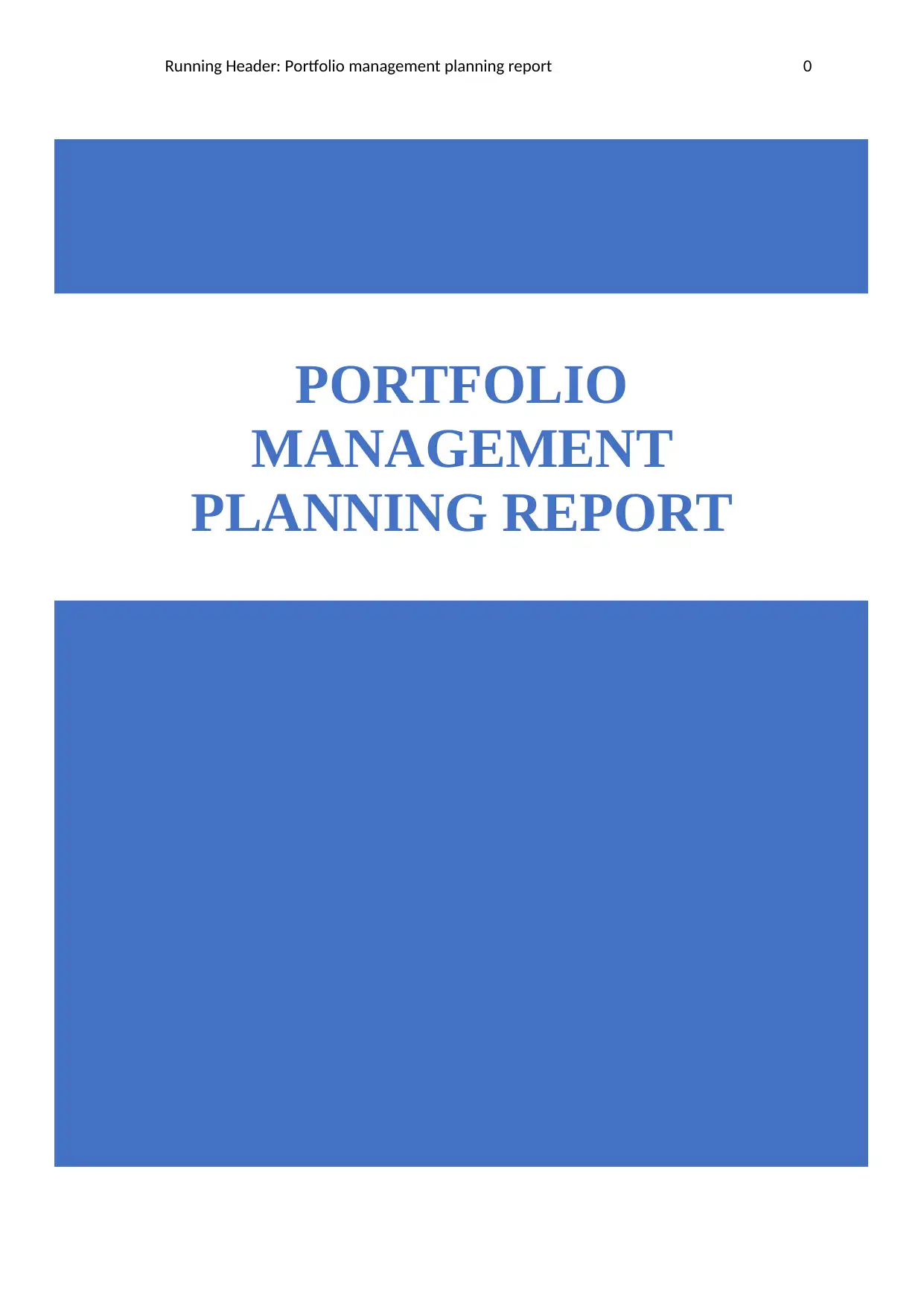
PORTFOLIO
MANAGEMENT
PLANNING REPORT
Running Header: Portfolio management planning report 0
MANAGEMENT
PLANNING REPORT
Running Header: Portfolio management planning report 0
Paraphrase This Document
Need a fresh take? Get an instant paraphrase of this document with our AI Paraphraser
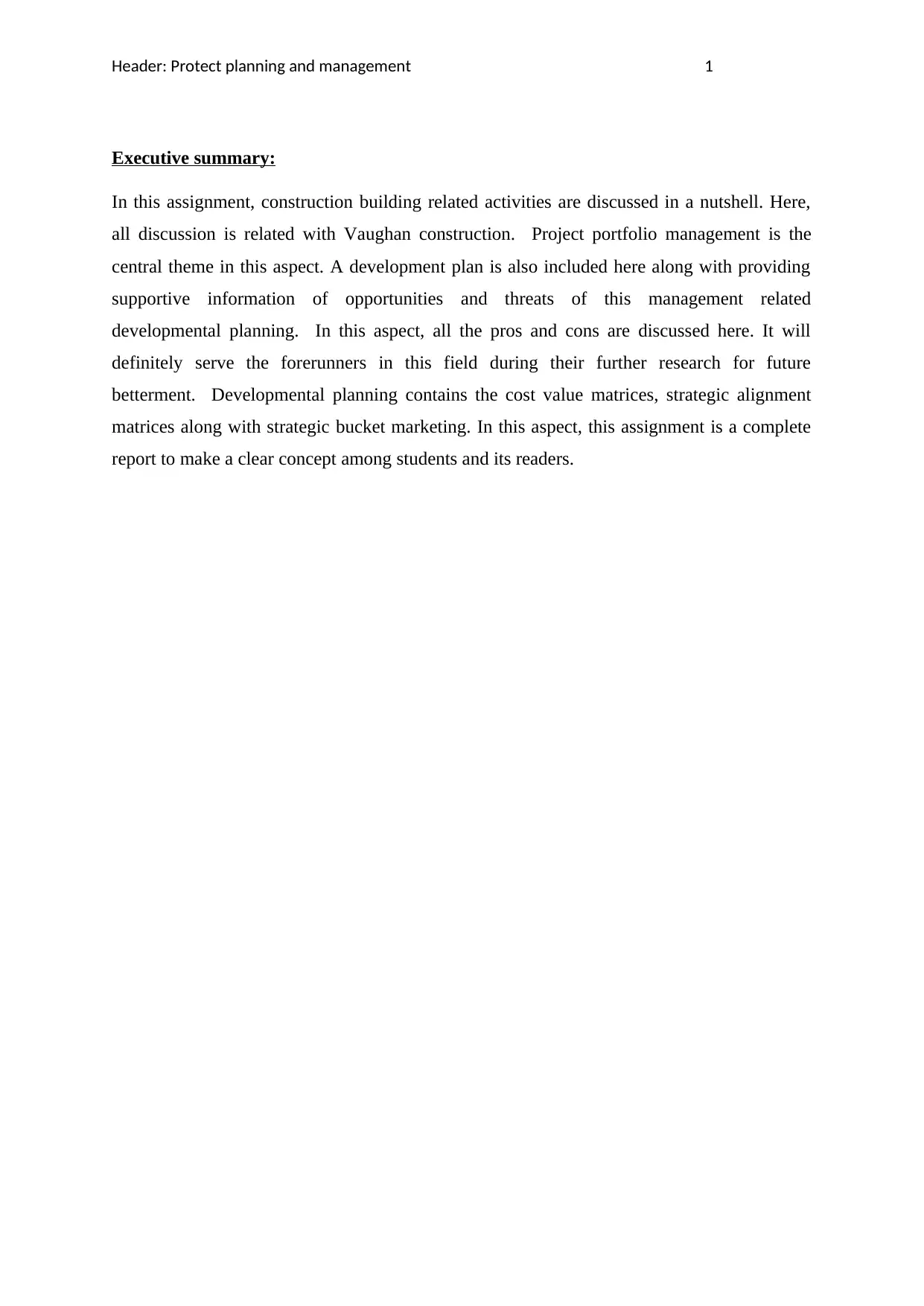
Header: Protect planning and management 1
Executive summary:
In this assignment, construction building related activities are discussed in a nutshell. Here,
all discussion is related with Vaughan construction. Project portfolio management is the
central theme in this aspect. A development plan is also included here along with providing
supportive information of opportunities and threats of this management related
developmental planning. In this aspect, all the pros and cons are discussed here. It will
definitely serve the forerunners in this field during their further research for future
betterment. Developmental planning contains the cost value matrices, strategic alignment
matrices along with strategic bucket marketing. In this aspect, this assignment is a complete
report to make a clear concept among students and its readers.
Executive summary:
In this assignment, construction building related activities are discussed in a nutshell. Here,
all discussion is related with Vaughan construction. Project portfolio management is the
central theme in this aspect. A development plan is also included here along with providing
supportive information of opportunities and threats of this management related
developmental planning. In this aspect, all the pros and cons are discussed here. It will
definitely serve the forerunners in this field during their further research for future
betterment. Developmental planning contains the cost value matrices, strategic alignment
matrices along with strategic bucket marketing. In this aspect, this assignment is a complete
report to make a clear concept among students and its readers.
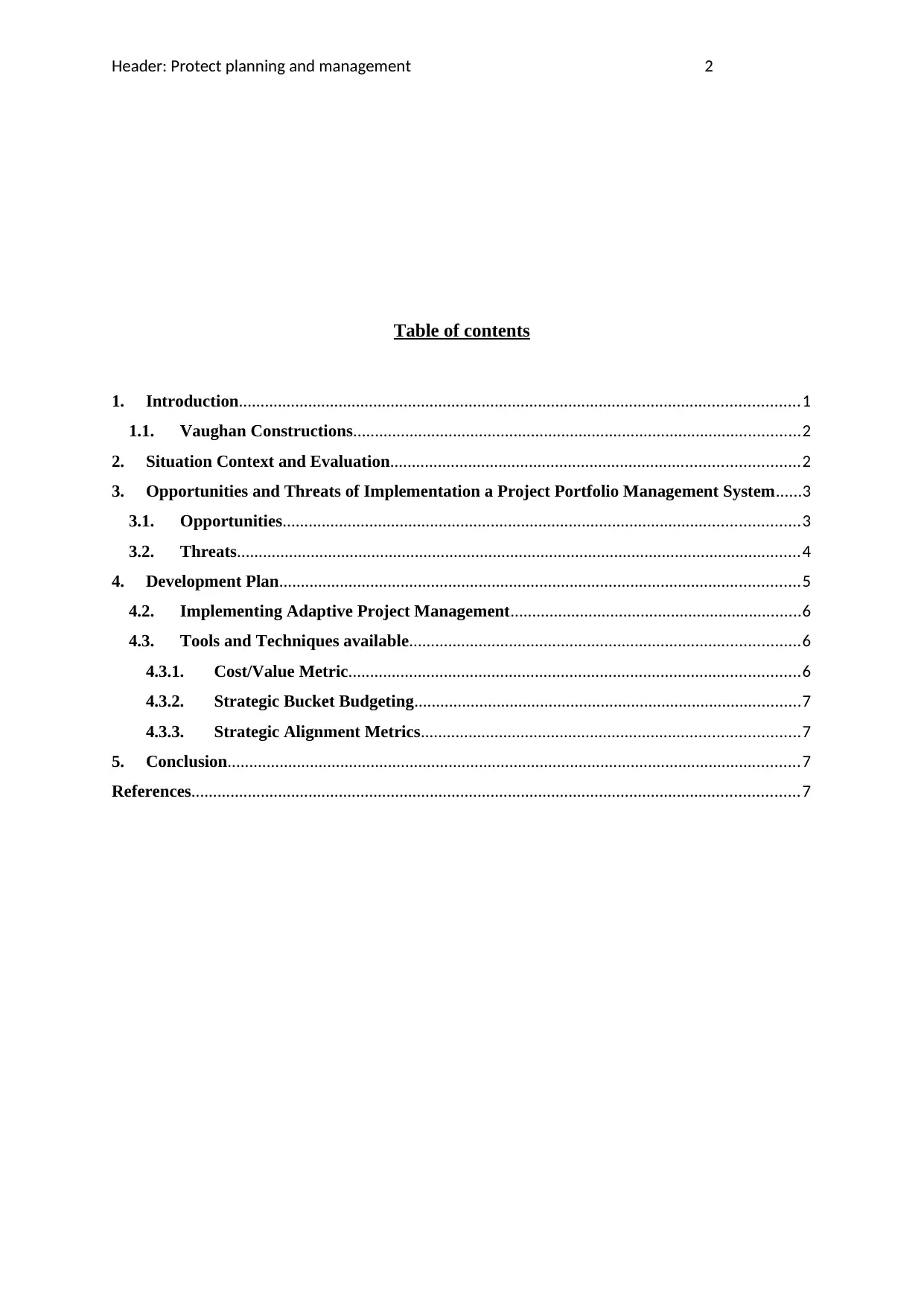
Header: Protect planning and management 2
Table of contents
1. Introduction.................................................................................................................................1
1.1. Vaughan Constructions.......................................................................................................2
2. Situation Context and Evaluation..............................................................................................2
3. Opportunities and Threats of Implementation a Project Portfolio Management System......3
3.1. Opportunities.......................................................................................................................3
3.2. Threats..................................................................................................................................4
4. Development Plan........................................................................................................................5
4.2. Implementing Adaptive Project Management...................................................................6
4.3. Tools and Techniques available..........................................................................................6
4.3.1. Cost/Value Metric........................................................................................................6
4.3.2. Strategic Bucket Budgeting.........................................................................................7
4.3.3. Strategic Alignment Metrics.......................................................................................7
5. Conclusion....................................................................................................................................7
References............................................................................................................................................7
Table of contents
1. Introduction.................................................................................................................................1
1.1. Vaughan Constructions.......................................................................................................2
2. Situation Context and Evaluation..............................................................................................2
3. Opportunities and Threats of Implementation a Project Portfolio Management System......3
3.1. Opportunities.......................................................................................................................3
3.2. Threats..................................................................................................................................4
4. Development Plan........................................................................................................................5
4.2. Implementing Adaptive Project Management...................................................................6
4.3. Tools and Techniques available..........................................................................................6
4.3.1. Cost/Value Metric........................................................................................................6
4.3.2. Strategic Bucket Budgeting.........................................................................................7
4.3.3. Strategic Alignment Metrics.......................................................................................7
5. Conclusion....................................................................................................................................7
References............................................................................................................................................7
⊘ This is a preview!⊘
Do you want full access?
Subscribe today to unlock all pages.

Trusted by 1+ million students worldwide
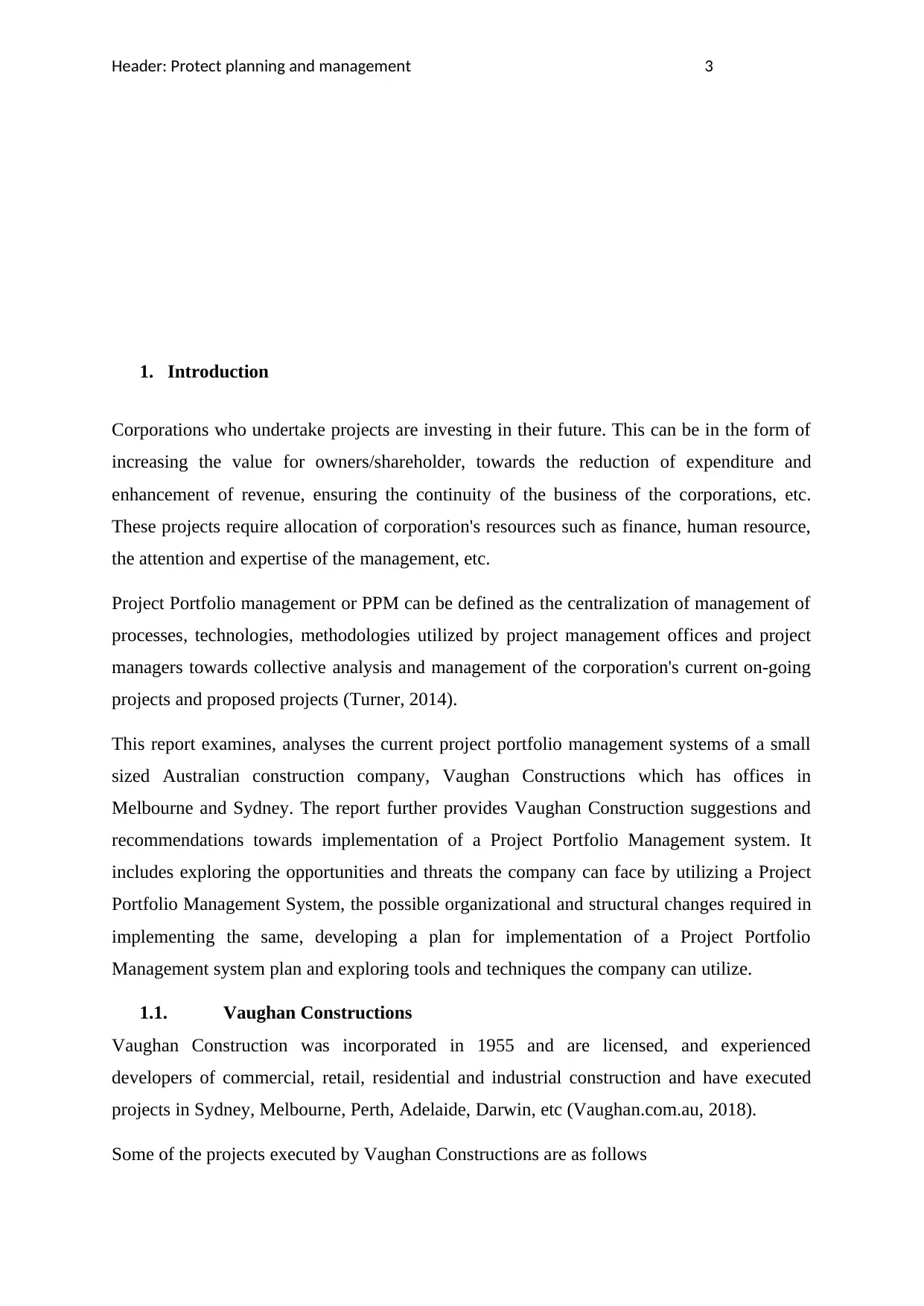
Header: Protect planning and management 3
1. Introduction
Corporations who undertake projects are investing in their future. This can be in the form of
increasing the value for owners/shareholder, towards the reduction of expenditure and
enhancement of revenue, ensuring the continuity of the business of the corporations, etc.
These projects require allocation of corporation's resources such as finance, human resource,
the attention and expertise of the management, etc.
Project Portfolio management or PPM can be defined as the centralization of management of
processes, technologies, methodologies utilized by project management offices and project
managers towards collective analysis and management of the corporation's current on-going
projects and proposed projects (Turner, 2014).
This report examines, analyses the current project portfolio management systems of a small
sized Australian construction company, Vaughan Constructions which has offices in
Melbourne and Sydney. The report further provides Vaughan Construction suggestions and
recommendations towards implementation of a Project Portfolio Management system. It
includes exploring the opportunities and threats the company can face by utilizing a Project
Portfolio Management System, the possible organizational and structural changes required in
implementing the same, developing a plan for implementation of a Project Portfolio
Management system plan and exploring tools and techniques the company can utilize.
1.1. Vaughan Constructions
Vaughan Construction was incorporated in 1955 and are licensed, and experienced
developers of commercial, retail, residential and industrial construction and have executed
projects in Sydney, Melbourne, Perth, Adelaide, Darwin, etc (Vaughan.com.au, 2018).
Some of the projects executed by Vaughan Constructions are as follows
1. Introduction
Corporations who undertake projects are investing in their future. This can be in the form of
increasing the value for owners/shareholder, towards the reduction of expenditure and
enhancement of revenue, ensuring the continuity of the business of the corporations, etc.
These projects require allocation of corporation's resources such as finance, human resource,
the attention and expertise of the management, etc.
Project Portfolio management or PPM can be defined as the centralization of management of
processes, technologies, methodologies utilized by project management offices and project
managers towards collective analysis and management of the corporation's current on-going
projects and proposed projects (Turner, 2014).
This report examines, analyses the current project portfolio management systems of a small
sized Australian construction company, Vaughan Constructions which has offices in
Melbourne and Sydney. The report further provides Vaughan Construction suggestions and
recommendations towards implementation of a Project Portfolio Management system. It
includes exploring the opportunities and threats the company can face by utilizing a Project
Portfolio Management System, the possible organizational and structural changes required in
implementing the same, developing a plan for implementation of a Project Portfolio
Management system plan and exploring tools and techniques the company can utilize.
1.1. Vaughan Constructions
Vaughan Construction was incorporated in 1955 and are licensed, and experienced
developers of commercial, retail, residential and industrial construction and have executed
projects in Sydney, Melbourne, Perth, Adelaide, Darwin, etc (Vaughan.com.au, 2018).
Some of the projects executed by Vaughan Constructions are as follows
Paraphrase This Document
Need a fresh take? Get an instant paraphrase of this document with our AI Paraphraser
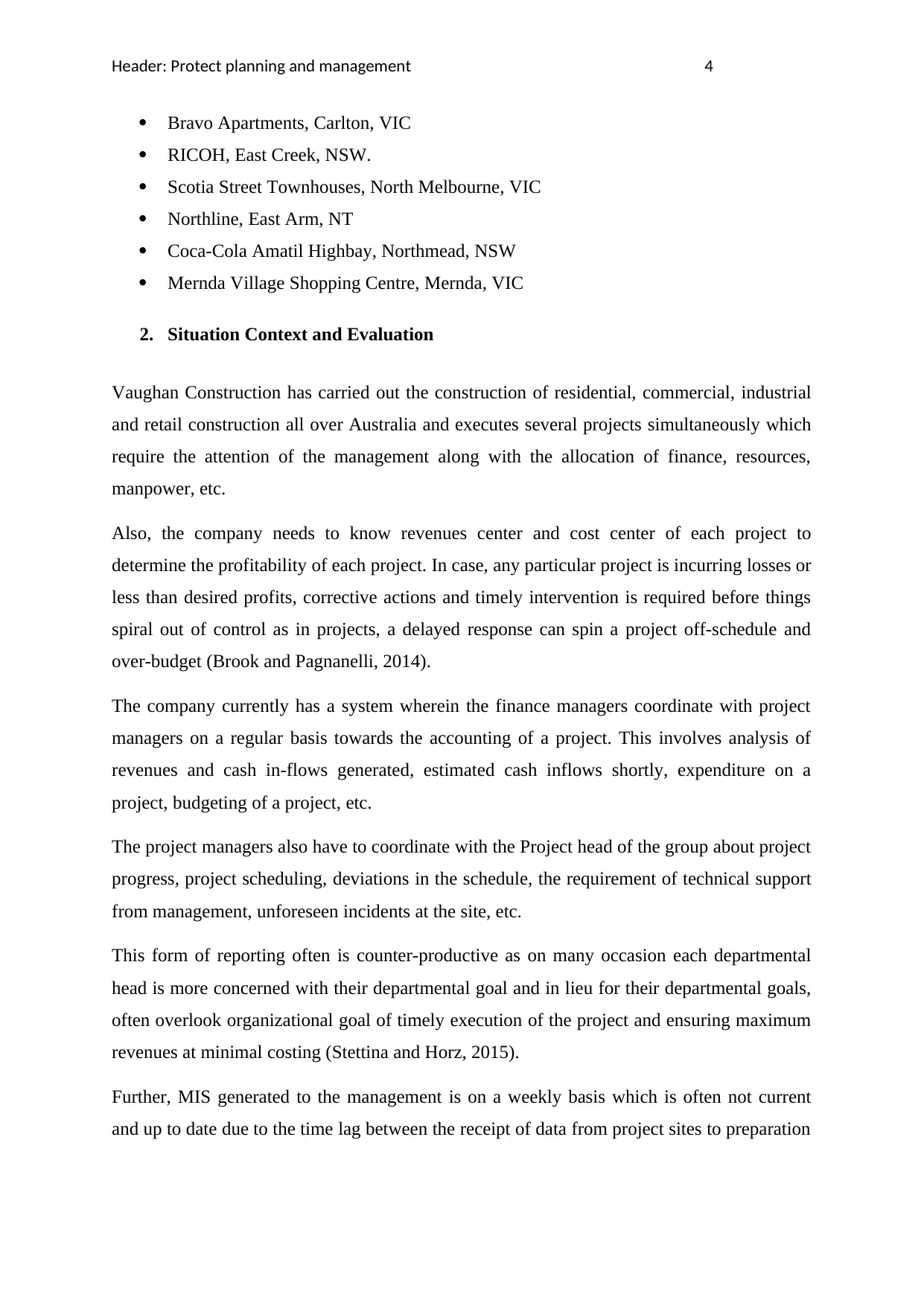
Header: Protect planning and management 4
Bravo Apartments, Carlton, VIC
RICOH, East Creek, NSW.
Scotia Street Townhouses, North Melbourne, VIC
Northline, East Arm, NT
Coca-Cola Amatil Highbay, Northmead, NSW
Mernda Village Shopping Centre, Mernda, VIC
2. Situation Context and Evaluation
Vaughan Construction has carried out the construction of residential, commercial, industrial
and retail construction all over Australia and executes several projects simultaneously which
require the attention of the management along with the allocation of finance, resources,
manpower, etc.
Also, the company needs to know revenues center and cost center of each project to
determine the profitability of each project. In case, any particular project is incurring losses or
less than desired profits, corrective actions and timely intervention is required before things
spiral out of control as in projects, a delayed response can spin a project off-schedule and
over-budget (Brook and Pagnanelli, 2014).
The company currently has a system wherein the finance managers coordinate with project
managers on a regular basis towards the accounting of a project. This involves analysis of
revenues and cash in-flows generated, estimated cash inflows shortly, expenditure on a
project, budgeting of a project, etc.
The project managers also have to coordinate with the Project head of the group about project
progress, project scheduling, deviations in the schedule, the requirement of technical support
from management, unforeseen incidents at the site, etc.
This form of reporting often is counter-productive as on many occasion each departmental
head is more concerned with their departmental goal and in lieu for their departmental goals,
often overlook organizational goal of timely execution of the project and ensuring maximum
revenues at minimal costing (Stettina and Horz, 2015).
Further, MIS generated to the management is on a weekly basis which is often not current
and up to date due to the time lag between the receipt of data from project sites to preparation
Bravo Apartments, Carlton, VIC
RICOH, East Creek, NSW.
Scotia Street Townhouses, North Melbourne, VIC
Northline, East Arm, NT
Coca-Cola Amatil Highbay, Northmead, NSW
Mernda Village Shopping Centre, Mernda, VIC
2. Situation Context and Evaluation
Vaughan Construction has carried out the construction of residential, commercial, industrial
and retail construction all over Australia and executes several projects simultaneously which
require the attention of the management along with the allocation of finance, resources,
manpower, etc.
Also, the company needs to know revenues center and cost center of each project to
determine the profitability of each project. In case, any particular project is incurring losses or
less than desired profits, corrective actions and timely intervention is required before things
spiral out of control as in projects, a delayed response can spin a project off-schedule and
over-budget (Brook and Pagnanelli, 2014).
The company currently has a system wherein the finance managers coordinate with project
managers on a regular basis towards the accounting of a project. This involves analysis of
revenues and cash in-flows generated, estimated cash inflows shortly, expenditure on a
project, budgeting of a project, etc.
The project managers also have to coordinate with the Project head of the group about project
progress, project scheduling, deviations in the schedule, the requirement of technical support
from management, unforeseen incidents at the site, etc.
This form of reporting often is counter-productive as on many occasion each departmental
head is more concerned with their departmental goal and in lieu for their departmental goals,
often overlook organizational goal of timely execution of the project and ensuring maximum
revenues at minimal costing (Stettina and Horz, 2015).
Further, MIS generated to the management is on a weekly basis which is often not current
and up to date due to the time lag between the receipt of data from project sites to preparation
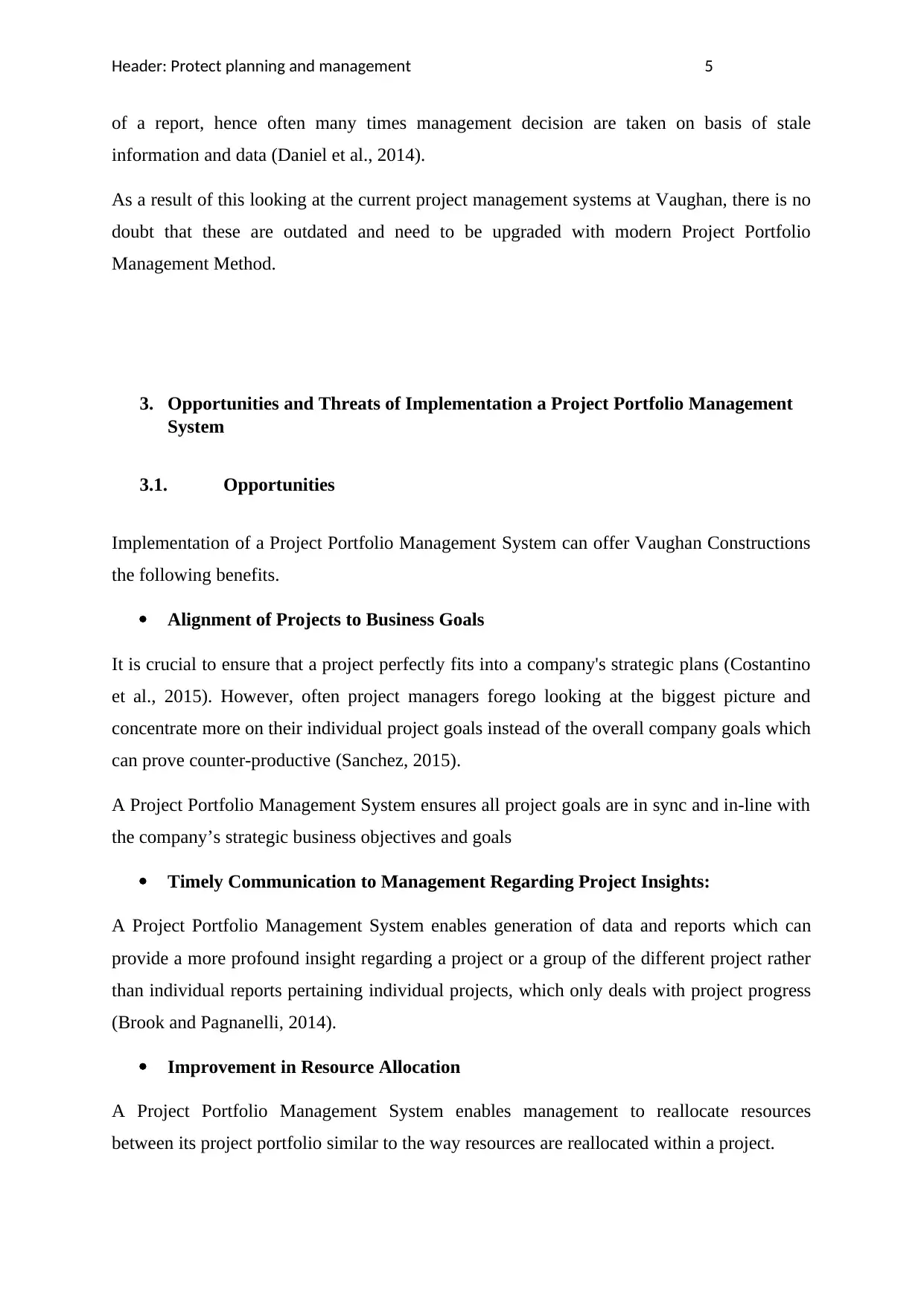
Header: Protect planning and management 5
of a report, hence often many times management decision are taken on basis of stale
information and data (Daniel et al., 2014).
As a result of this looking at the current project management systems at Vaughan, there is no
doubt that these are outdated and need to be upgraded with modern Project Portfolio
Management Method.
3. Opportunities and Threats of Implementation a Project Portfolio Management
System
3.1. Opportunities
Implementation of a Project Portfolio Management System can offer Vaughan Constructions
the following benefits.
Alignment of Projects to Business Goals
It is crucial to ensure that a project perfectly fits into a company's strategic plans (Costantino
et al., 2015). However, often project managers forego looking at the biggest picture and
concentrate more on their individual project goals instead of the overall company goals which
can prove counter-productive (Sanchez, 2015).
A Project Portfolio Management System ensures all project goals are in sync and in-line with
the company’s strategic business objectives and goals
Timely Communication to Management Regarding Project Insights:
A Project Portfolio Management System enables generation of data and reports which can
provide a more profound insight regarding a project or a group of the different project rather
than individual reports pertaining individual projects, which only deals with project progress
(Brook and Pagnanelli, 2014).
Improvement in Resource Allocation
A Project Portfolio Management System enables management to reallocate resources
between its project portfolio similar to the way resources are reallocated within a project.
of a report, hence often many times management decision are taken on basis of stale
information and data (Daniel et al., 2014).
As a result of this looking at the current project management systems at Vaughan, there is no
doubt that these are outdated and need to be upgraded with modern Project Portfolio
Management Method.
3. Opportunities and Threats of Implementation a Project Portfolio Management
System
3.1. Opportunities
Implementation of a Project Portfolio Management System can offer Vaughan Constructions
the following benefits.
Alignment of Projects to Business Goals
It is crucial to ensure that a project perfectly fits into a company's strategic plans (Costantino
et al., 2015). However, often project managers forego looking at the biggest picture and
concentrate more on their individual project goals instead of the overall company goals which
can prove counter-productive (Sanchez, 2015).
A Project Portfolio Management System ensures all project goals are in sync and in-line with
the company’s strategic business objectives and goals
Timely Communication to Management Regarding Project Insights:
A Project Portfolio Management System enables generation of data and reports which can
provide a more profound insight regarding a project or a group of the different project rather
than individual reports pertaining individual projects, which only deals with project progress
(Brook and Pagnanelli, 2014).
Improvement in Resource Allocation
A Project Portfolio Management System enables management to reallocate resources
between its project portfolio similar to the way resources are reallocated within a project.
⊘ This is a preview!⊘
Do you want full access?
Subscribe today to unlock all pages.

Trusted by 1+ million students worldwide
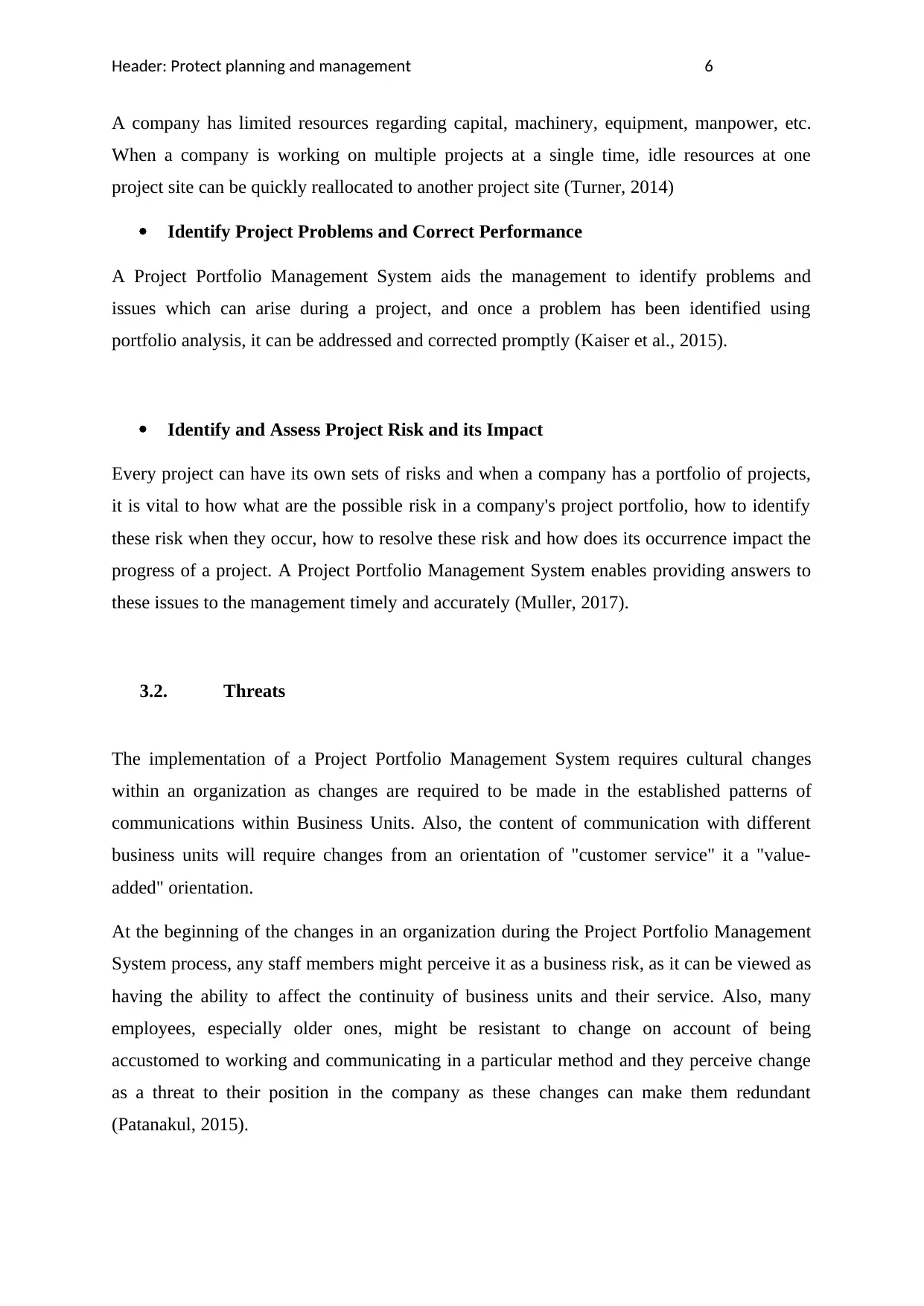
Header: Protect planning and management 6
A company has limited resources regarding capital, machinery, equipment, manpower, etc.
When a company is working on multiple projects at a single time, idle resources at one
project site can be quickly reallocated to another project site (Turner, 2014)
Identify Project Problems and Correct Performance
A Project Portfolio Management System aids the management to identify problems and
issues which can arise during a project, and once a problem has been identified using
portfolio analysis, it can be addressed and corrected promptly (Kaiser et al., 2015).
Identify and Assess Project Risk and its Impact
Every project can have its own sets of risks and when a company has a portfolio of projects,
it is vital to how what are the possible risk in a company's project portfolio, how to identify
these risk when they occur, how to resolve these risk and how does its occurrence impact the
progress of a project. A Project Portfolio Management System enables providing answers to
these issues to the management timely and accurately (Muller, 2017).
3.2. Threats
The implementation of a Project Portfolio Management System requires cultural changes
within an organization as changes are required to be made in the established patterns of
communications within Business Units. Also, the content of communication with different
business units will require changes from an orientation of "customer service" it a "value-
added" orientation.
At the beginning of the changes in an organization during the Project Portfolio Management
System process, any staff members might perceive it as a business risk, as it can be viewed as
having the ability to affect the continuity of business units and their service. Also, many
employees, especially older ones, might be resistant to change on account of being
accustomed to working and communicating in a particular method and they perceive change
as a threat to their position in the company as these changes can make them redundant
(Patanakul, 2015).
A company has limited resources regarding capital, machinery, equipment, manpower, etc.
When a company is working on multiple projects at a single time, idle resources at one
project site can be quickly reallocated to another project site (Turner, 2014)
Identify Project Problems and Correct Performance
A Project Portfolio Management System aids the management to identify problems and
issues which can arise during a project, and once a problem has been identified using
portfolio analysis, it can be addressed and corrected promptly (Kaiser et al., 2015).
Identify and Assess Project Risk and its Impact
Every project can have its own sets of risks and when a company has a portfolio of projects,
it is vital to how what are the possible risk in a company's project portfolio, how to identify
these risk when they occur, how to resolve these risk and how does its occurrence impact the
progress of a project. A Project Portfolio Management System enables providing answers to
these issues to the management timely and accurately (Muller, 2017).
3.2. Threats
The implementation of a Project Portfolio Management System requires cultural changes
within an organization as changes are required to be made in the established patterns of
communications within Business Units. Also, the content of communication with different
business units will require changes from an orientation of "customer service" it a "value-
added" orientation.
At the beginning of the changes in an organization during the Project Portfolio Management
System process, any staff members might perceive it as a business risk, as it can be viewed as
having the ability to affect the continuity of business units and their service. Also, many
employees, especially older ones, might be resistant to change on account of being
accustomed to working and communicating in a particular method and they perceive change
as a threat to their position in the company as these changes can make them redundant
(Patanakul, 2015).
Paraphrase This Document
Need a fresh take? Get an instant paraphrase of this document with our AI Paraphraser
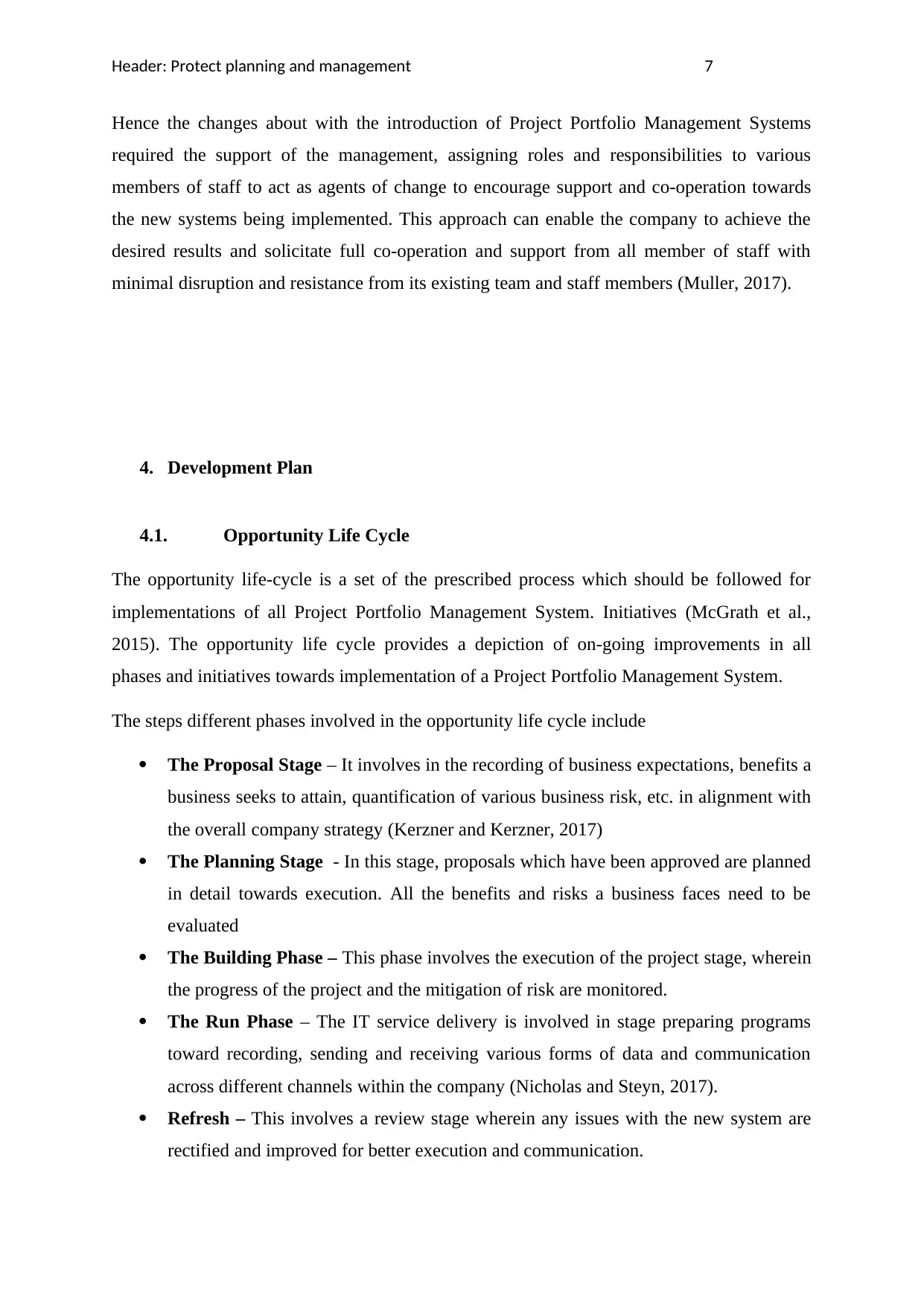
Header: Protect planning and management 7
Hence the changes about with the introduction of Project Portfolio Management Systems
required the support of the management, assigning roles and responsibilities to various
members of staff to act as agents of change to encourage support and co-operation towards
the new systems being implemented. This approach can enable the company to achieve the
desired results and solicitate full co-operation and support from all member of staff with
minimal disruption and resistance from its existing team and staff members (Muller, 2017).
4. Development Plan
4.1. Opportunity Life Cycle
The opportunity life-cycle is a set of the prescribed process which should be followed for
implementations of all Project Portfolio Management System. Initiatives (McGrath et al.,
2015). The opportunity life cycle provides a depiction of on-going improvements in all
phases and initiatives towards implementation of a Project Portfolio Management System.
The steps different phases involved in the opportunity life cycle include
The Proposal Stage – It involves in the recording of business expectations, benefits a
business seeks to attain, quantification of various business risk, etc. in alignment with
the overall company strategy (Kerzner and Kerzner, 2017)
The Planning Stage - In this stage, proposals which have been approved are planned
in detail towards execution. All the benefits and risks a business faces need to be
evaluated
The Building Phase – This phase involves the execution of the project stage, wherein
the progress of the project and the mitigation of risk are monitored.
The Run Phase – The IT service delivery is involved in stage preparing programs
toward recording, sending and receiving various forms of data and communication
across different channels within the company (Nicholas and Steyn, 2017).
Refresh – This involves a review stage wherein any issues with the new system are
rectified and improved for better execution and communication.
Hence the changes about with the introduction of Project Portfolio Management Systems
required the support of the management, assigning roles and responsibilities to various
members of staff to act as agents of change to encourage support and co-operation towards
the new systems being implemented. This approach can enable the company to achieve the
desired results and solicitate full co-operation and support from all member of staff with
minimal disruption and resistance from its existing team and staff members (Muller, 2017).
4. Development Plan
4.1. Opportunity Life Cycle
The opportunity life-cycle is a set of the prescribed process which should be followed for
implementations of all Project Portfolio Management System. Initiatives (McGrath et al.,
2015). The opportunity life cycle provides a depiction of on-going improvements in all
phases and initiatives towards implementation of a Project Portfolio Management System.
The steps different phases involved in the opportunity life cycle include
The Proposal Stage – It involves in the recording of business expectations, benefits a
business seeks to attain, quantification of various business risk, etc. in alignment with
the overall company strategy (Kerzner and Kerzner, 2017)
The Planning Stage - In this stage, proposals which have been approved are planned
in detail towards execution. All the benefits and risks a business faces need to be
evaluated
The Building Phase – This phase involves the execution of the project stage, wherein
the progress of the project and the mitigation of risk are monitored.
The Run Phase – The IT service delivery is involved in stage preparing programs
toward recording, sending and receiving various forms of data and communication
across different channels within the company (Nicholas and Steyn, 2017).
Refresh – This involves a review stage wherein any issues with the new system are
rectified and improved for better execution and communication.
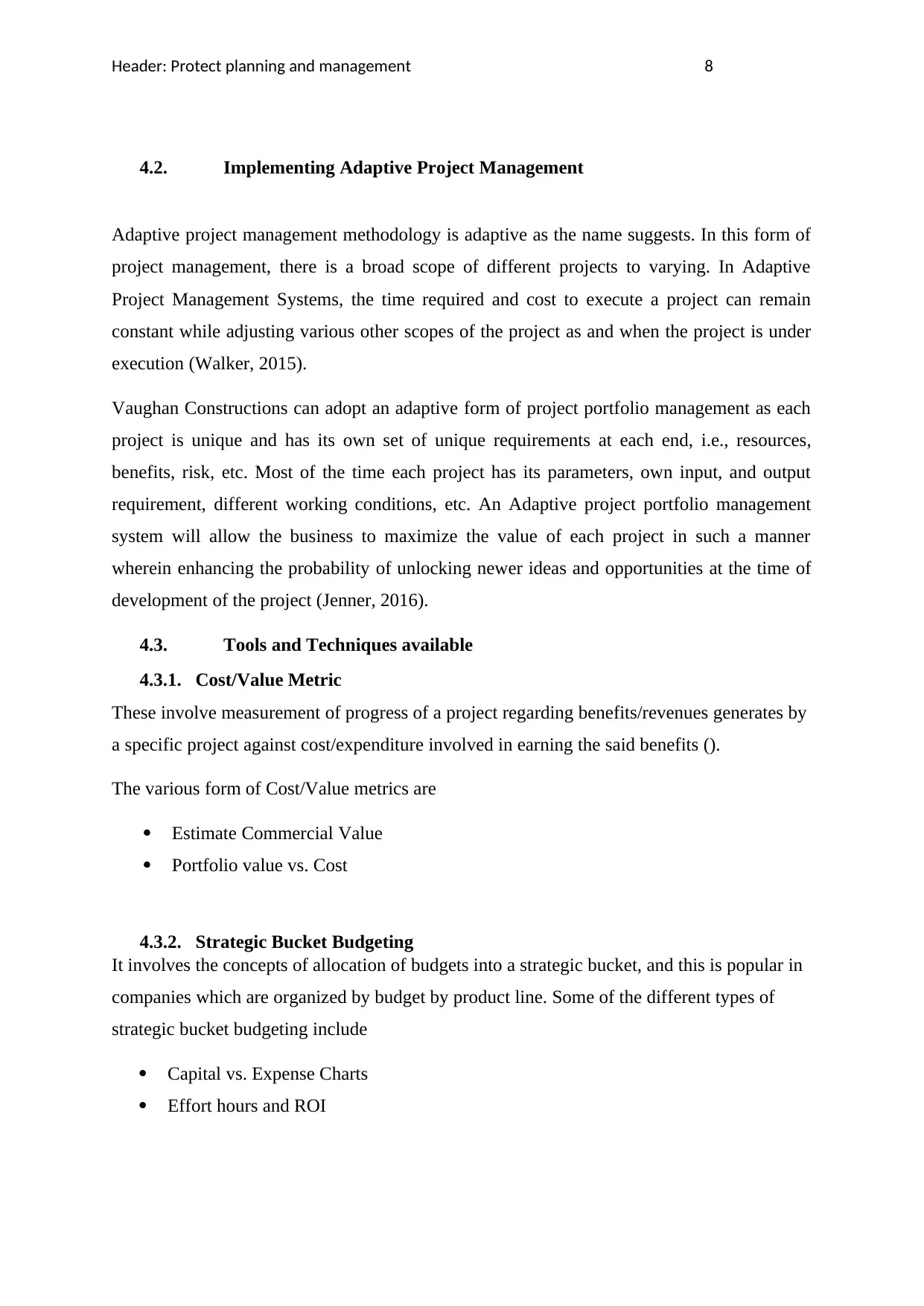
Header: Protect planning and management 8
4.2. Implementing Adaptive Project Management
Adaptive project management methodology is adaptive as the name suggests. In this form of
project management, there is a broad scope of different projects to varying. In Adaptive
Project Management Systems, the time required and cost to execute a project can remain
constant while adjusting various other scopes of the project as and when the project is under
execution (Walker, 2015).
Vaughan Constructions can adopt an adaptive form of project portfolio management as each
project is unique and has its own set of unique requirements at each end, i.e., resources,
benefits, risk, etc. Most of the time each project has its parameters, own input, and output
requirement, different working conditions, etc. An Adaptive project portfolio management
system will allow the business to maximize the value of each project in such a manner
wherein enhancing the probability of unlocking newer ideas and opportunities at the time of
development of the project (Jenner, 2016).
4.3. Tools and Techniques available
4.3.1. Cost/Value Metric
These involve measurement of progress of a project regarding benefits/revenues generates by
a specific project against cost/expenditure involved in earning the said benefits ().
The various form of Cost/Value metrics are
Estimate Commercial Value
Portfolio value vs. Cost
4.3.2. Strategic Bucket Budgeting
It involves the concepts of allocation of budgets into a strategic bucket, and this is popular in
companies which are organized by budget by product line. Some of the different types of
strategic bucket budgeting include
Capital vs. Expense Charts
Effort hours and ROI
4.2. Implementing Adaptive Project Management
Adaptive project management methodology is adaptive as the name suggests. In this form of
project management, there is a broad scope of different projects to varying. In Adaptive
Project Management Systems, the time required and cost to execute a project can remain
constant while adjusting various other scopes of the project as and when the project is under
execution (Walker, 2015).
Vaughan Constructions can adopt an adaptive form of project portfolio management as each
project is unique and has its own set of unique requirements at each end, i.e., resources,
benefits, risk, etc. Most of the time each project has its parameters, own input, and output
requirement, different working conditions, etc. An Adaptive project portfolio management
system will allow the business to maximize the value of each project in such a manner
wherein enhancing the probability of unlocking newer ideas and opportunities at the time of
development of the project (Jenner, 2016).
4.3. Tools and Techniques available
4.3.1. Cost/Value Metric
These involve measurement of progress of a project regarding benefits/revenues generates by
a specific project against cost/expenditure involved in earning the said benefits ().
The various form of Cost/Value metrics are
Estimate Commercial Value
Portfolio value vs. Cost
4.3.2. Strategic Bucket Budgeting
It involves the concepts of allocation of budgets into a strategic bucket, and this is popular in
companies which are organized by budget by product line. Some of the different types of
strategic bucket budgeting include
Capital vs. Expense Charts
Effort hours and ROI
⊘ This is a preview!⊘
Do you want full access?
Subscribe today to unlock all pages.

Trusted by 1+ million students worldwide
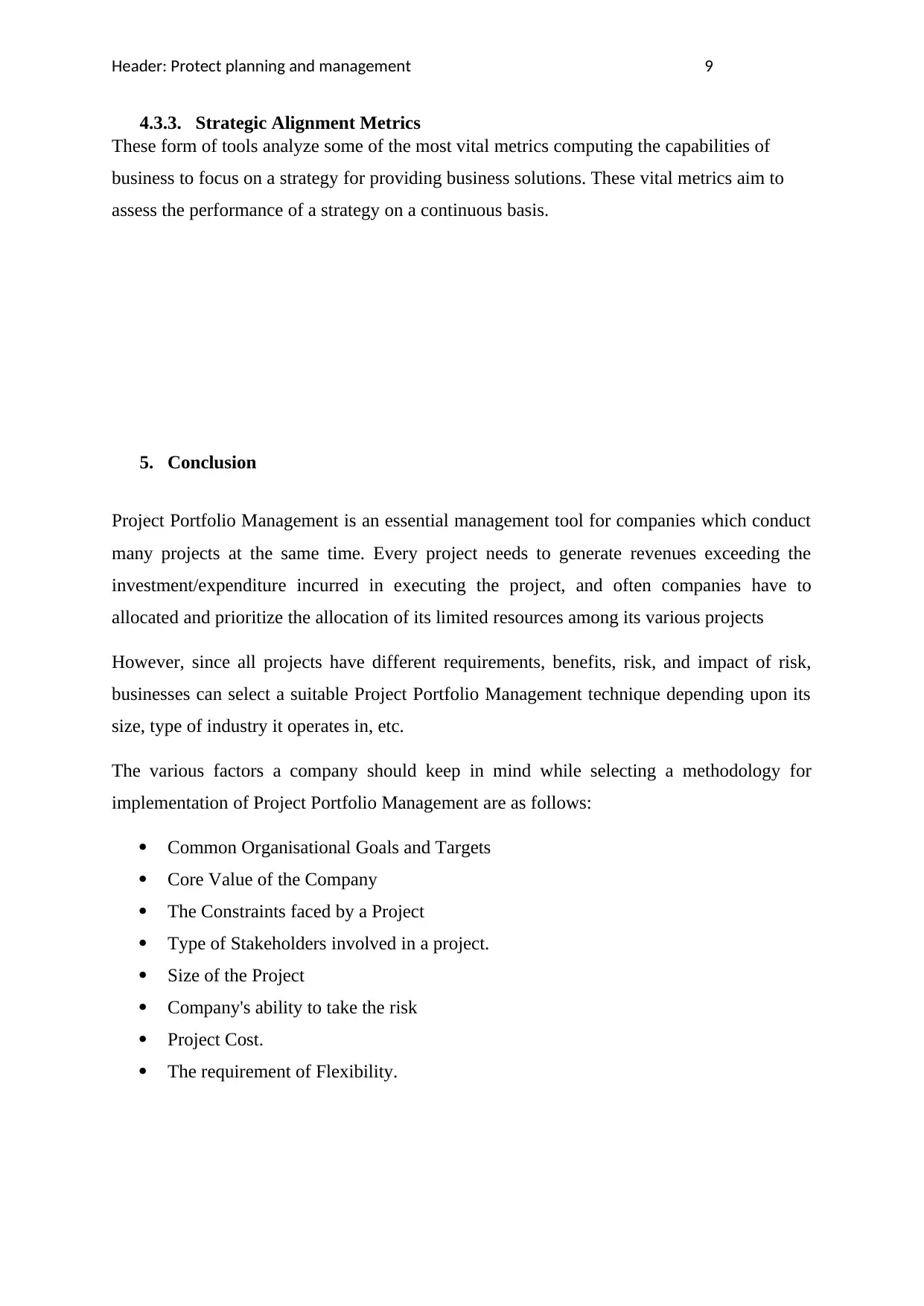
Header: Protect planning and management 9
4.3.3. Strategic Alignment Metrics
These form of tools analyze some of the most vital metrics computing the capabilities of
business to focus on a strategy for providing business solutions. These vital metrics aim to
assess the performance of a strategy on a continuous basis.
5. Conclusion
Project Portfolio Management is an essential management tool for companies which conduct
many projects at the same time. Every project needs to generate revenues exceeding the
investment/expenditure incurred in executing the project, and often companies have to
allocated and prioritize the allocation of its limited resources among its various projects
However, since all projects have different requirements, benefits, risk, and impact of risk,
businesses can select a suitable Project Portfolio Management technique depending upon its
size, type of industry it operates in, etc.
The various factors a company should keep in mind while selecting a methodology for
implementation of Project Portfolio Management are as follows:
Common Organisational Goals and Targets
Core Value of the Company
The Constraints faced by a Project
Type of Stakeholders involved in a project.
Size of the Project
Company's ability to take the risk
Project Cost.
The requirement of Flexibility.
4.3.3. Strategic Alignment Metrics
These form of tools analyze some of the most vital metrics computing the capabilities of
business to focus on a strategy for providing business solutions. These vital metrics aim to
assess the performance of a strategy on a continuous basis.
5. Conclusion
Project Portfolio Management is an essential management tool for companies which conduct
many projects at the same time. Every project needs to generate revenues exceeding the
investment/expenditure incurred in executing the project, and often companies have to
allocated and prioritize the allocation of its limited resources among its various projects
However, since all projects have different requirements, benefits, risk, and impact of risk,
businesses can select a suitable Project Portfolio Management technique depending upon its
size, type of industry it operates in, etc.
The various factors a company should keep in mind while selecting a methodology for
implementation of Project Portfolio Management are as follows:
Common Organisational Goals and Targets
Core Value of the Company
The Constraints faced by a Project
Type of Stakeholders involved in a project.
Size of the Project
Company's ability to take the risk
Project Cost.
The requirement of Flexibility.
Paraphrase This Document
Need a fresh take? Get an instant paraphrase of this document with our AI Paraphraser
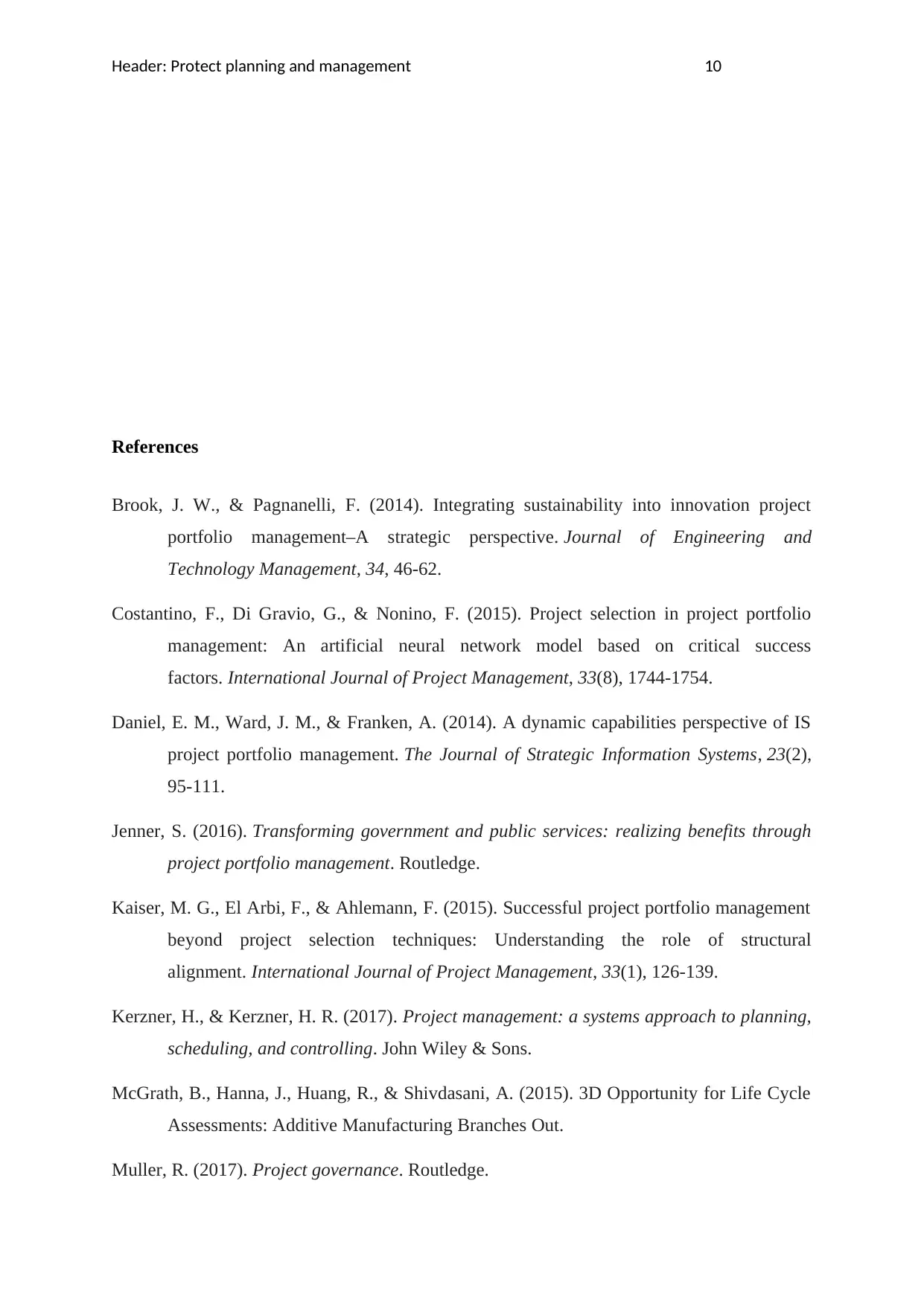
Header: Protect planning and management 10
References
Brook, J. W., & Pagnanelli, F. (2014). Integrating sustainability into innovation project
portfolio management–A strategic perspective. Journal of Engineering and
Technology Management, 34, 46-62.
Costantino, F., Di Gravio, G., & Nonino, F. (2015). Project selection in project portfolio
management: An artificial neural network model based on critical success
factors. International Journal of Project Management, 33(8), 1744-1754.
Daniel, E. M., Ward, J. M., & Franken, A. (2014). A dynamic capabilities perspective of IS
project portfolio management. The Journal of Strategic Information Systems, 23(2),
95-111.
Jenner, S. (2016). Transforming government and public services: realizing benefits through
project portfolio management. Routledge.
Kaiser, M. G., El Arbi, F., & Ahlemann, F. (2015). Successful project portfolio management
beyond project selection techniques: Understanding the role of structural
alignment. International Journal of Project Management, 33(1), 126-139.
Kerzner, H., & Kerzner, H. R. (2017). Project management: a systems approach to planning,
scheduling, and controlling. John Wiley & Sons.
McGrath, B., Hanna, J., Huang, R., & Shivdasani, A. (2015). 3D Opportunity for Life Cycle
Assessments: Additive Manufacturing Branches Out.
Muller, R. (2017). Project governance. Routledge.
References
Brook, J. W., & Pagnanelli, F. (2014). Integrating sustainability into innovation project
portfolio management–A strategic perspective. Journal of Engineering and
Technology Management, 34, 46-62.
Costantino, F., Di Gravio, G., & Nonino, F. (2015). Project selection in project portfolio
management: An artificial neural network model based on critical success
factors. International Journal of Project Management, 33(8), 1744-1754.
Daniel, E. M., Ward, J. M., & Franken, A. (2014). A dynamic capabilities perspective of IS
project portfolio management. The Journal of Strategic Information Systems, 23(2),
95-111.
Jenner, S. (2016). Transforming government and public services: realizing benefits through
project portfolio management. Routledge.
Kaiser, M. G., El Arbi, F., & Ahlemann, F. (2015). Successful project portfolio management
beyond project selection techniques: Understanding the role of structural
alignment. International Journal of Project Management, 33(1), 126-139.
Kerzner, H., & Kerzner, H. R. (2017). Project management: a systems approach to planning,
scheduling, and controlling. John Wiley & Sons.
McGrath, B., Hanna, J., Huang, R., & Shivdasani, A. (2015). 3D Opportunity for Life Cycle
Assessments: Additive Manufacturing Branches Out.
Muller, R. (2017). Project governance. Routledge.
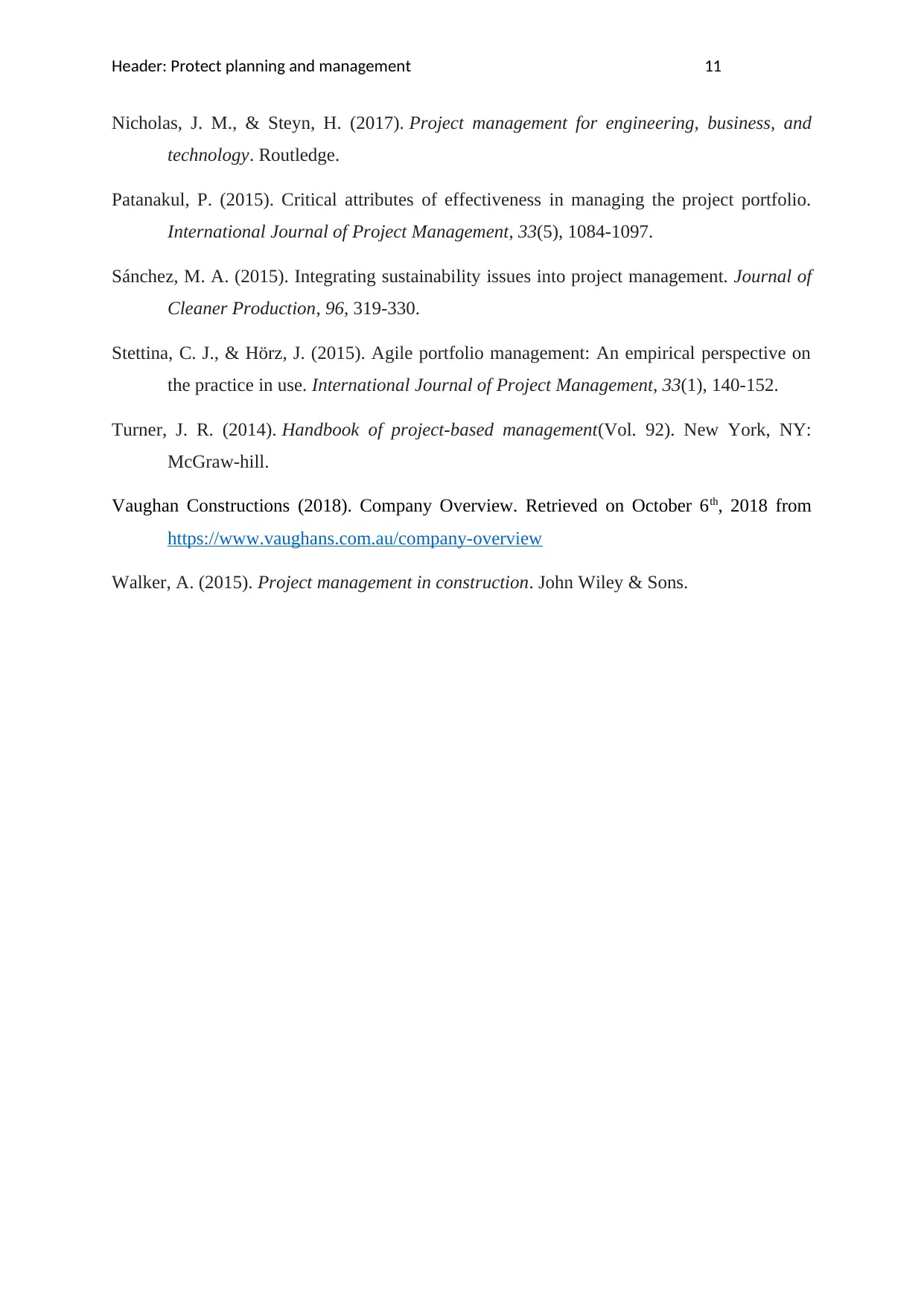
Header: Protect planning and management 11
Nicholas, J. M., & Steyn, H. (2017). Project management for engineering, business, and
technology. Routledge.
Patanakul, P. (2015). Critical attributes of effectiveness in managing the project portfolio.
International Journal of Project Management, 33(5), 1084-1097.
Sánchez, M. A. (2015). Integrating sustainability issues into project management. Journal of
Cleaner Production, 96, 319-330.
Stettina, C. J., & Hörz, J. (2015). Agile portfolio management: An empirical perspective on
the practice in use. International Journal of Project Management, 33(1), 140-152.
Turner, J. R. (2014). Handbook of project-based management(Vol. 92). New York, NY:
McGraw-hill.
Vaughan Constructions (2018). Company Overview. Retrieved on October 6th, 2018 from
https://www.vaughans.com.au/company-overview
Walker, A. (2015). Project management in construction. John Wiley & Sons.
Nicholas, J. M., & Steyn, H. (2017). Project management for engineering, business, and
technology. Routledge.
Patanakul, P. (2015). Critical attributes of effectiveness in managing the project portfolio.
International Journal of Project Management, 33(5), 1084-1097.
Sánchez, M. A. (2015). Integrating sustainability issues into project management. Journal of
Cleaner Production, 96, 319-330.
Stettina, C. J., & Hörz, J. (2015). Agile portfolio management: An empirical perspective on
the practice in use. International Journal of Project Management, 33(1), 140-152.
Turner, J. R. (2014). Handbook of project-based management(Vol. 92). New York, NY:
McGraw-hill.
Vaughan Constructions (2018). Company Overview. Retrieved on October 6th, 2018 from
https://www.vaughans.com.au/company-overview
Walker, A. (2015). Project management in construction. John Wiley & Sons.
⊘ This is a preview!⊘
Do you want full access?
Subscribe today to unlock all pages.

Trusted by 1+ million students worldwide
1 out of 12
Your All-in-One AI-Powered Toolkit for Academic Success.
+13062052269
info@desklib.com
Available 24*7 on WhatsApp / Email
![[object Object]](/_next/static/media/star-bottom.7253800d.svg)
Unlock your academic potential
Copyright © 2020–2025 A2Z Services. All Rights Reserved. Developed and managed by ZUCOL.